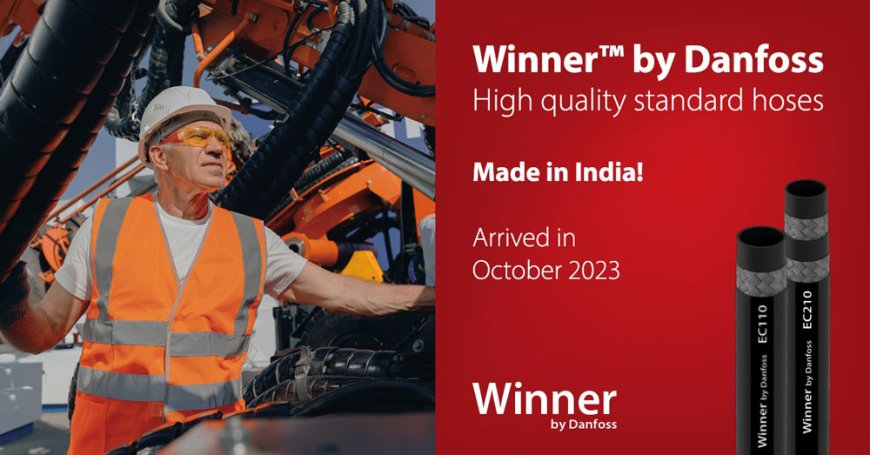Hydraulic hose: be safe not sorry

While the unexpected failure of a hydraulic hose can cause construction, agricultural, forestry, and other off-highway vehicles to come to a halt, there is another major implication of this undesirable event: compromised safety. Skin burns and injection injuries from hose defects, and whipping from detached hose are just some of the dangers that can result from unexpected failures. Ensuring the optimal selection, assembly, and routing of this core hydraulic system component is therefore of paramount importance.
There are many indicators of hose safety. One of the most apparent is the so-called ‘safety factor’. A reputable hydraulic hose will carry a safety factor of 4:1, as defined in EN, SAE, and ISO standards. Thus, if the working pressure of the hose is specified as 200 bar, the burst pressure will be 800 bar. However, this is just one small way to confirm hose safety. Among many other criteria is impulse life.
The impulse testing of a hydraulic hose sets out an extremely useful way to evaluate its safety and reliability. Impulse testing subjects the hydraulic hose to repeated high and low-pressure cycles, simulating real-life operating conditions. With safety performance in mind, the upper hydraulic pressure for this test will typically be 1.2 or 1.33 times the working pressure defined for the product. The test is highly effective at determining the ability of the hose to withstand pressure spikes, pulsations, and pressure reversals. By comparing the impulse life of different hydraulic hose solutions, original equipment manufacturers (OEMs) and maintenance crews can deliver a significant boost to system safety.
The cost of failure
Aspects such as impulse life and hose safety factor are critical in avoiding accidents and injuries. A burst hose, for example, can present many hazards to workers. In the first instance, hydraulic oil is quite hot at typically 70-120°C, causing skin burns. Splashes can also present a danger to the eyes.
Even worse is the potential for hydraulic oil injection into the body. Although rare, penetration injuries can result from high-speed, high-pressure oil escaping from a pinhole defect in the hose.
Hose blow-off, where it detaches from its fitting under pressure, presents an entirely different danger: whipping. The result can be a painful one for any workers in close proximity.
Be prepared
There are several ways to protect against these undesirable outcomes. For instance, aside from checking impulse life and burst pressure, correct hose preparation and connection are vital. Issues such as the aforementioned fitting blow-off can result from incorrect crimping diameter or improper placement of the hose inside the fitting.
It’s very important to use a hose and fitting from the same manufacturer. By doing so, users know the components are qualified and tested correctly. There are many manufacturers that produce only hose or fittings, necessitating independent qualification to ensure the components can work together safely.
Opting for a manufacturer that can provide both hose and fittings is a far safer choice. Such a supplier will also be able to provide customers with clear assembly instructions: the factors to consider when cutting the hose, skiving the hose, and when applying the fitting. In all cases, the advice is to take an extra safety step by using tooling and accessories from the hose manufacturer.
Crimp diameter is another critical factor. Assembly must take place in accordance with the hose/fitting supplier’s qualified crimp diameter. It’s important to measure this dimension after crimping. The manufacturer will have crimp specifications for each hose/fitting combination based on the impulse tests and burst pressure tests among other tests performed during qualification. Once the hose is assembled with fittings, some safety-critical applications can benefit from final proof testing in a dedicated high-pressure rig. Typically, the proof testing of hydraulic hose assemblies takes place at two times the specified working pressure.
Do not bend the rules
When it comes to routing hydraulic hose, there are number of best-practice guidelines that help to ensure safety, including those for hose bending.
The bend radius essentially sets out the maximum flexibility of the hose. It’s the radius at which impulse testing takes place. Bending the hose more than the radius specified by the manufacturer might not cause immediate failure, but lifetime will certainly reduce, often considerably. A typical hydraulic hose has three main layers, usually with a reinforced (steel wire) mesh located between an inner and outer layer. Over-bending the hose can spread the wire mesh, leading to premature hose failures.
Another point of note is to avoid bending the hose near the fitting, which is essentially its weakest point. Bending too close to the fitting can make this zone even weaker, potentially resulting in hose blow-off. The recommendation set out in standards is to ensure a straight section of hose beyond the fitting equal to at least 1.5 times the outer diameter.
Bend radius is a principal catalog-listed parameter for hydraulic hose, alongside working pressure, lifetime, and temperature resistance. Temperature arguably has the biggest influence on the lifetime of rubber polymers. It can accelerate the aging process significantly if hose use takes place outside of specified temperature limits. Cracks will begin to appear, ultimately leading to unexpected failure. If a hydraulic application involves very high or low temperatures, the hose selection process (with reference to special polymers) must take this factor into consideration.
Tell-tale signs
International standards set out certain hose criteria for inspectors to check during routine maintenance or service routines. First and foremost, never ignore a damaged outer jacket. Cracks, for example, indicate hose aging and the need for replacement. If left, moisture can penetrate cracks and promote corrosion, with hose failure the ultimate result.
Abrasion is another visible defect, occurring when a hose comes into contact with another hose or part of the machine. Where abrasion is evident, it’s of course possible to replace the hose, but better still is to devise a solution that avoids the issue returning. Options here include changing the hose assembly routing, using a more abrasion-resistant hose, deploying additional sleeves over the hose, and smoothing/rounding the edges of nearby machine features.
The presence of oil or oil film on the hose or fitting is a further clear indicator that hose replacement is necessary.
In all instances, the recommendation is to avoid attempting any hydraulic hose repairs. With the pressures and temperatures involved, safety relies on taking the correct remedial action: replacement. Impromptu hose repairs involving inadequate materials such as tapes or foams are highly unadvisable, even if the budget is under scrutiny.
Astute selection
Making the optimal hose selection for the application is always the first critical step in delivering a safe hydraulic system. A reputable manufacturer such as Danfoss Power Solutions has an extensive offer for those seeking safe, reliable, long-life hose. A case in point is the Aeroquip EC881 Dynamax, a two-wire braided hose qualified to 1 million impulse cycles. This tough and abrasion-resistant hose provides a lighter weight, more flexible option for high-pressure applications normally dependent upon four-spiral hose. It outperforms standard EN857 2SC hose in pressure rating, operating temperature, impulse life, and abrasion resistance. In fact, it offers eight times higher abrasion resistance than EN857 2SC counterparts.
While much hydraulic hose safety is about common sense, the advice of a reputable manufacturer such as Danfoss Power Solutions will prove invaluable in ensuring the safety of operatives and maintenance personnel over the machine’s service life. The voice of experience is always the safest.

Salih Karayagiz,







